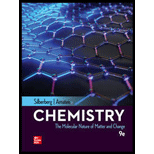
Concept explainers
(a)
Interpretation:
Whether orange juice is a compound, a homogenous mixture or a heterogeneous mixture is to be determined.
Concept introduction:
Compounds are formed by the combination of two or more different elements in a fixed ratio. Compounds are represented by using chemical formulas which contain the alphabetical
A mixture consists of a combination of two or more compounds which are physically intermingled. The components of a mixture do not lose their individual identity. The components of a mixture are not
(b)
Interpretation:
Whether vegetable soup is a compound, a homogenous mixture or a heterogeneous mixture is to be determined.
Concept introduction:
Compounds are formed by the combination of two or more different elements in a fixed ratio. Compounds are represented by using chemical formulas which contain the alphabetical symbols representing the elements they are composed of and numbers which represent the total number of atoms of each element that they are made of.
A mixture consists of a combination of two or more compounds which are physically intermingled. The components of a mixture do not lose their individual identity. The components of a mixture are not chemically bonded to each other. Therefore, the mixture components can be separated using physical method.
(c)
Interpretation:
Whether cement is a compound, a homogenous mixture or a heterogeneous mixture is to be determined.
Concept introduction:
Compounds are formed by the combination of two or more different elements in a fixed ratio. Compounds are represented by using chemical formulas which contain the alphabetical symbols representing the elements they are composed of and numbers which represent the total number of atoms of each element that they are made of.
A mixture consists of a combination of two or more compounds which are physically intermingled. The components of a mixture do not lose their individual identity. The components of a mixture are not chemically bonded to each other. Therefore, the mixture components can be separated using physical method.
(d)
Interpretation:
Whether calcium sulphate is a compound, a homogenous mixture or a heterogeneous mixture is to be determined.
Concept introduction:
Compounds are formed by the combination of two or more different elements in a fixed ratio. Compounds are represented by using chemical formulas which contain the alphabetical symbols representing the elements they are composed of and numbers which represent the total number of atoms of each element that they are made of.
A mixture consists of a combination of two or more compounds which are physically intermingled. The components of a mixture do not lose their individual identity. The components of a mixture are not chemically bonded to each other. Therefore, the mixture components can be separated using physical method.
(e)
Interpretation:
Whether tea is a compound, a homogenous mixture or a heterogeneous mixture is to be determined.
Concept introduction:
Compounds are formed by the combination of two or more different elements in a fixed ratio. Compounds are represented by using chemical formulas which contain the alphabetical symbols representing the elements they are composed of and numbers which represent the total number of atoms of each element that they are made of.
A mixture consists of a combination of two or more compounds which are physically intermingled. The components of a mixture do not lose their individual identity. The components of a mixture are not chemically bonded to each other. Therefore, the mixture components can be separated using physical method.
Want to see the full answer?
Check out a sample textbook solution
Chapter 2 Solutions
Chemistry: The Molecular Nature of Matter and Change
- V Biological Macromolecules Drawing the Haworth projection of an aldose from its Fischer projection Draw a Haworth projection of a common cyclic form of this monosaccharide: H C=O HO H HO H H OH CH₂OH Explanation Check Click and drag to start drawing a structure. Xarrow_forwardComplete the mechanismarrow_forwardComplete the mechanismarrow_forward
- 8 00 6 = 10 10 Decide whether each of the molecules in the table below is stable, in the exact form in which it is drawn, at pH = 11. If you decide at least one molecule is not stable, then redraw one of the unstable molecules in its stable form below the table. (If more than unstable, you can pick any of them to redraw.) Check OH stable HO stable Ounstable unstable O OH stable unstable OH 80 F6 F5 stable Ounstable X Save For Later Sub 2025 McGraw Hill LLC. All Rights Reserved. Terms of Use | Privacy C ཀྭ་ A F7 매 F8 F9 4 F10arrow_forwardJust try completing it and it should be straightforward according to the professor and TAs.arrow_forwardThe grading is not on correctness, so if you can just get to the correct answers without perfectionism that would be great. They care about the steps and reasoning and that you did something. I asked for an extension, but was denied the extension.arrow_forward
 ChemistryChemistryISBN:9781305957404Author:Steven S. Zumdahl, Susan A. Zumdahl, Donald J. DeCostePublisher:Cengage Learning
ChemistryChemistryISBN:9781305957404Author:Steven S. Zumdahl, Susan A. Zumdahl, Donald J. DeCostePublisher:Cengage Learning ChemistryChemistryISBN:9781259911156Author:Raymond Chang Dr., Jason Overby ProfessorPublisher:McGraw-Hill Education
ChemistryChemistryISBN:9781259911156Author:Raymond Chang Dr., Jason Overby ProfessorPublisher:McGraw-Hill Education Principles of Instrumental AnalysisChemistryISBN:9781305577213Author:Douglas A. Skoog, F. James Holler, Stanley R. CrouchPublisher:Cengage Learning
Principles of Instrumental AnalysisChemistryISBN:9781305577213Author:Douglas A. Skoog, F. James Holler, Stanley R. CrouchPublisher:Cengage Learning Organic ChemistryChemistryISBN:9780078021558Author:Janice Gorzynski Smith Dr.Publisher:McGraw-Hill Education
Organic ChemistryChemistryISBN:9780078021558Author:Janice Gorzynski Smith Dr.Publisher:McGraw-Hill Education Chemistry: Principles and ReactionsChemistryISBN:9781305079373Author:William L. Masterton, Cecile N. HurleyPublisher:Cengage Learning
Chemistry: Principles and ReactionsChemistryISBN:9781305079373Author:William L. Masterton, Cecile N. HurleyPublisher:Cengage Learning Elementary Principles of Chemical Processes, Bind...ChemistryISBN:9781118431221Author:Richard M. Felder, Ronald W. Rousseau, Lisa G. BullardPublisher:WILEY
Elementary Principles of Chemical Processes, Bind...ChemistryISBN:9781118431221Author:Richard M. Felder, Ronald W. Rousseau, Lisa G. BullardPublisher:WILEY





